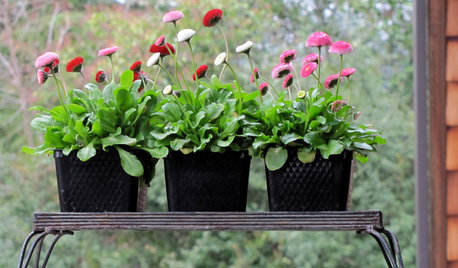PLANNING THE SPRING AND SUMMER GARDENING ACTIVITIES: In late winter, I always try to look at what the weather is doing and then make adjustments to my gardening plans accordingly. If a dry year looms, I might postpone the decision to plant a lot of trees, for example, since it is harder for them to get well-established during a drought year. If a wet year looms, I am much more careful in what I plant and where I plant it, knowing that perpetually wet roots are hard on (and deadly for) some plants.
TAKING LA NINA INTO CONSIDERATION: I've only been aware of and understood La Nina's effects on my gardening practices since the mid-1990s and feel like I still have a lot more to learn and understand about La Nina. However, as the years pass, I have become increasingly aware that, for most of us in Oklahoma and the south-central and southern U.S., La Nina is bad news.
HOW LA NINA AFFECTS THE U.S.: Well, for many parts of the country (but not the south), La Nina brings a huge increase in moisture. If you look at the precipitation totals for many parts of the country (but not Oklahoma), you can see that this is true this year. In particular, the snowfall totals in many parts of the country are just staggering. Unfortunately, in many of the same parts of the country, La Nina brings warmer than typical weather. So, between the excess precipitation and the cycles of warmer weather, flooding can become a huge issue, and we've already seen quite a lot of that as well in those parts of the country.
Unfortunately, for most of us southerners, La Nina means dryer and warmer weather than usual....not just in winter, but for however long the La Nina pattern lasts. It is this 'feature' of La Nina that makes me nervous about the 2008 gardening year.
WINTER 2007-2008: In south-central Oklahoma we have been both drier and warmer than usual this winter. For us, the rains decreased drastically from late July 2007 onward and our moisture totals are way down. Prior to our recent 2" of rainfall, we were classified by the U. S. Drought Monitor as "abnormally dry", and I haven't looked at the monitor to see if the 2" changed that classification.
This winter, south-central Oklahoma has experienced its' fifth-driest winter on record. Our rainfall since December 1st, for example, totals less than 2.5", or roughly one-third of what we normally get in that timeframe.
WHAT IT MEANS FOR MY YARD AND GARDEN (AND PERHAPS YOURS AS WELL): So, I'm going into the gardening season here with dry, parched ground at a time when I usually have nice, moist soil. Ponds that are usually full to the point of being overflowing are about 25% full. I mostly consider all of this a negative. However, in one regard, it is a good thing--and that is for the tomatoes I grow (more on that later).
LATEST FORECAST FOR LA NINA 2008: When it becomes apparent that a La Nina weather pattern is beginning, scientists really cannot predict how long it will last. However, as the weeks and months go on, they can tell how persistent the La Nina pattern appears to be and will then begin telling us how long they think it may last. The current feeling is that this is a stronger-than-usual La Nina and that it will persist for a longer-than-usual period of time, perhaps into the summer and fall of 2008. Not good news.
PLANNING ON HOW TO COPE WITH THIS LA NINA: For the home landscape, I probably won't plant any new trees this year. I do intend to plant some shrubs as I expand the mixed borders on the north, east and south sides of the house, but will probably add more organic material to the soil than I normally would, will add a significantly heavier layer of mulch, and will pay extremely close attention to the shrubs' moisture needs and irrigate accordingly.
In the veggie garden, I will plan on pretty much the usual spring-planted crops but also will plan on not having a fall garden if the La Nina pattern persists.
The last time that La Nina persisted into the summer, I chose to completely quit watering the veggie garden in mid-June and didn't have a fall garden either. There was just no way on earth that I could afford the amount of water the garden needed. Incidentally, many of my gardening neighbors did exactly the same thing at pretty much the same time. It took all the $$$ we could afford just to keep the lawn area around the house green enough that we felt like we had at least minimal fire protection.
When it comes to flowers, this year I will stick more to the tried-and-true heatloving annuals. The perennials, of course, are already well-estabished and should survive with good mulching and watering. For me, La Nina doesn't affect our flowers much, mostly because I only plant the ones that can tolerate extreme heat and drought to begin with.
When it comes to veggies, I'll plant the usual ones but with more organic material in the soil, more mulch on top of the soil, and more consistent irrigation earlier in the season. (It's no use waiting for the rain "to come" if it is not likely to come, is it?)
THE UPSIDE TO LA NINA: Of course, there's got to be some sort of upside, right? As long as the garden receives consistent moisture in the spring, good crops are almost guaranteed. The lack of moisture and lower humidity mean significantly less disease pressure. Crops that love heat, including okra, sweet potatoes and black-eyed peas should have an especially great year. So will beans, corn, peppers, melons, etc. The key is to water enough to produce a crop but not too much, as excess water can literally "water down" the flavor of melons and tomatoes in particular.
TOMATOES: Drier conditions almost always mean a great tomato crop....up to a point. As long as I give the tomatoes consistent moisture, and keep them mulched, I'll get a great May and June harvest. After that, though, it just depends of how much (if any) rain falls. In drier years, tomato foliage disease are almost nil since many of them need moisture to flourish. And, as long as I restrict my watering to the use of soaker hoses and drip irrigation, there won't be any moisture on the leaves. The WORST thing (and I learned this the hard way) to do to the tomatoes in a La Nina year (and, really, any year) is to water with sprinklers that put lots of water on the foliage. This just leaves to tremendous disease problems.
One way I am changing my tomato-growing practices to cope with the expected drier-than-usual weather is that I am growing MANY more determinates than usual so I can grow them in containers where I have better control over soil moisture levels.
Having said that, though, I DO have to occasionally wet down the tomato foliage during excessively dry weather, but I do it using a sprayer that has water mixed with either liquid seaweed, liquid fish fertilizer or compost tea and not plain water.
HOT, DRY WEATHER AND PESTS: If our La Nina pattern persists into the summer and fall as expected, it probably will be a bad grasshopper year, especially in rural areas. For me, that means I will monitor grasshopper levels carefully in March, and will use Nolo Bait as needed in April to early May, if it is needed at all. Nolo Bait DOES work, but works best on hoppers that are in the earliest instars, so using it early gives best results.
Spider mites are worse in dry, dusty weather so I will be on the watch for them. The key to spider mites is to catch them early and do somthing then before their population gets wildly out of control. In Texas, I usually didn't see spider mites until July. Here in southern Oklahoma, though, I will see them as early as mid-May in a very hot, dry year.
Fire ants are another pest that gives me more trouble in drier weather. Most years, even though the fire ants are around, they aren't much "trouble". I will treat mounds in the veggie garden with the best organic fire ant control available, which at the present time seems to be any serenade-based product. In very hot, dry weather, though, the ants move closer to the house (probably for the irrigated soil) and even try to come into the house looking for food. So, I am expecting a bad fire ant year.
Many other pests are often not as bad in dry weather since they need certain moisture levels to survive. Since I depend so much on beneficial insects to help keep the bad bugs under control, I will plant and maintain foods they need for survival. I also can feed them bug food if necessary.
WILDLIFE: Drier weather usually causes big problems for those of us in rural areas with abundant wildlife. On our property, we tend to see more deer, rabbits, possums, etc. in dry years and they will eat a lot of our ornamental plants and veggies if given the chance. However, we usually see fewer snakes in hotter and drier weather. (Yippee!)
OK, y'all, there it is. La Nina is here and I am planning on how to cope with it. And, if I had a choice, I'd choose a La Nina over an El Nino anytime, BUT I'd rather have neither.
I've linked the OCS data page so that you can see where your winter stacks up as far as being wetter or drier than usual. If you go to that page and click on the box that says WINTER TO DATE, you can see how your region's winter weather compares to historical records.
Oh, and one more thing.....I'm taking off my gardener's hat and putting on my fire chief wife's hat: the last La Nina contributed greatly to the horrible wildfire season of 2005-2006 during which our small deparment fought hundreds more fires than usual. Enough said.
Dawn
Here is a link that might be useful: Oklahoma Climatological Data














Macmex
Okiedawn OK Zone 7Original Author
Related Discussions
2008 Garden Resolutions
Q
Jeanne La Joie - 2008 Flash - full bush
Q
2008 LA County Fair PIX !!!
Q
Is it really going to be a La Nina year?
Q
Macmex
scottokla
wolflover
Okiedawn OK Zone 7Original Author
wolflover
Okiedawn OK Zone 7Original Author